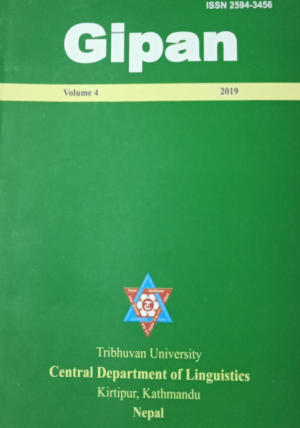Retroflexion in Nepali
DOI:
https://doi.org/10.3126/gipan.v4i0.35453Keywords:
Retroflexion, Nepali, platography, linguography, apicalityAbstract
Nepali, an Indo-Aryan language spoken in Nepal along with India and Bhutan, and some parts of Burma, possesses three coronal stops (2 plosives and 1 affricate). Retroflexion is traditionally considered as the distinctive feature between two different types of plosives. Though retroflexion in Nepali is considered- like in the case of other Indo-Aryan languages- a fundamental distinctive articulatory parameter (Bhat 1973, Ladefoged and Bhaskararao 1983, Ladefoged and Maddieson 1996), Pokharel (1989), however, claims that there is no retroflex category in Nepali, because the “so-called” (sic.) Nepali retroflex stops are not produced with the “tongue tip curling back” as it is described in the traditional grammar. In this work, I have tried to show that this claim is just one side of the story and that the “retroflex” as a phonetic and phonological category “does exist” in Nepali. Based on two different palatographic and linguographic studies (of 9 speakers – four females and five males- of Nepal) I have presented a different scenario than that of Pokharel, without completely denying his claim.
Downloads
Downloads
Published
How to Cite
Issue
Section
License
This license enables reusers to distribute, remix, adapt, and build upon the material in any medium or format for noncommercial purposes only, and only so long as attribution is given to the creator.

